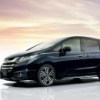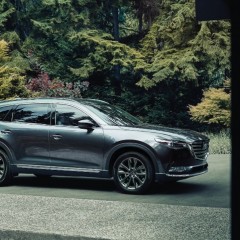Search the Community
Showing results for tags 'your'.
-
...starts blowing hot air (literally) while smelling of some metallic-tinged rotten fish, first, turn off your aircon. Chances are what you're inhaling is the refrigerant that's somehow leaking into the aircon system. Which, incidentally, is rather unhealthy, to say the least. Mine did, recently, and the cause was traced to a corroded cooling coil that had to be replaced. Got the job done (removed, replaced all within 4 hours - coil comes with a 1 year warranty) by one chirpy Peter Seat (interestingly enough) who also fixed back my glovebox a whole lot better than the now-defunct dealer ever could. Well, here's something Fluffy won't be encountering in his car.
-
For me, it's really good. Especially the rice which is not oily at all. Very clean environment including the toilets. Apparently Mei Chin Market really not patronised by many.
-
I advised u guys to use cash for payments in m'sia... my credit card account was been illegally used. HSBC called me. and now I already received the billing. from the transactions records and my memories recall, there is indeed something fishy about the waiter during my last transaction... it was in JB's city sq, SEED Cafe... the staffs there might not be "clean".. Guys, avoid card payment in m'sia, esp JB...
-
i just kenna my front bumper 3 times today....becos wifey wants to eat at some hotel...haizzz...got to touch up the damage ALONE after that....the KRRRACCCKKK sound is so painful to my ears.... Amazingly...after knocking my front bumpers for nearly 40 times...take a peek below and you can see the whole bottom got Battle Scars...but no cracks ley...PU not too bad a material to use for bodykit..STRONG.... To all the forumers with low front bumpers....please share with us how durable is your front bumper and what material it is made of??
-
Color and Personality In the United Kingdom, research suggested that the color of your car says something about your personality type. And accordingly, based on your personality type, your likeliness to be involved in an accident (in the U.K. at least). That research showed that black cars are twice as likely to be involved in crashes as cream-color cars. Whether this is true in the United States is unclear. Just for fun, here is what the research implied about certain car colors (listed in order of most dangerous to least)1. Black cars denote an aggressive personality or someone who's an outsider or rebel. Silver cars indicate someone who's cool, calm and slightly aloof. Green cars can often be chosen by people with hysterical tendencies. Yellow cars signify someone who is idealistic and novelty loving. Blue cars are chosen by the more introspective, reflective and cautious driver. Gray cars represent those who are calm, sober and dedicated to their work. Red cars denote those who are full of zest, energy and drive and who think, move and talk quickly. Pink cars are chosen by gentle, loving and affectionate drivers. White cars represent status-seeking extrovert drivers. Cream cars are the least likely to be involved in accidents and denote self-contained and controlled owners. https://www.comparisonmarket.com/LearningCe....aspx/index/455
-
Hello! So, what's the HIGHEST SPEED you've ever driven using the car you OWN? I'd be glad if someone can share his car rated top-speed vs the actual highest speed ever achieved on his car? My car's a Hafei Minz and its top speed is 110km/h. Over the weekend, I took a couple of friends to Johor for a yummy dinner. I travelled on the Malaysian highway for the first time via the 2nd Link. Guess what, I pushed my Minz to close to 130 km/h (can't read that clearly due to the car shaking)! Phew! It was such an astounding feat for me! But I need quite a long stretch of highway to do that and I dare not push it any further as the car got rather shaky. Please share your experience. Thanks.
- 624 replies
-
Tried it just now and find it over-rated. Portion is small and a very stingy serving of laksa gravy with it. Add $1 of cockles but dun feel much of it. 1st and last time for me.
-
Hey guys, as above topic. I find it very hard to shampoo, rinse etc the very top of the car. Recently, I started bringing down a knee-height wooden stool but it's hard work getting up and down. Just want to find out how do you guys do it? I notice the kiosks' car washes usually have a mop-like thingy but wana find out how DIY washers do it
-
kinda of quiet lately hor? lets show case ur baby! be it current or ex owners! mine:
-
alot of my colleagues and friends shun away from the thought of a korean made car. alot of remarks like: "will spoil very easy" "japanese better" "waste money" personally i think Koreans have come a long way and has made its mark worldwide. And i guess if you give china made cars another 10 years, it will succeed too. but there is one thing i hate about korean made. The depreciation. Urgh.
-
Please recommend and share your experience with GPS car Navigation system i really louya pok at driving directions and will confirm go wrong route. definitely buying a GPS. now here's what i am looking for.... - budget is $350 to $410 - can key in postal code/building name/road name to get to destination - voice guidance to tell me directions, eg, to keep left "keep left, turn left in 300m", "keep left, turn left in 200m" - updated and updatable map - place where i can buy it also pls share any other experience you have with GPS and the model you are using
- 35 replies
-
http://www.divaasia.com/article/4205 Sun, Jun 28, 2009 The Star/Asia News Network Cheated on for 20 years I AM a 49-year-old housewife who has been married to a policeman for 23 years. We have 21-year-old twins who are in their first year at university. My husband has been cheating on me for almost 20 years. He is a womaniser. He sleeps with any woman who offers her body for free. He had a mistress in the 1990s. He even told me that he wanted to marry her but he didn
-
Inspired by another thread in this sub-forum...I thought it will be interesting to share about this. Will share my experience later
-
Check your CV joint and dust covers, mine busted around 10k ago and did not check now have knocking sound as all the grease is probably gone and the part is rubbing on my internal wheel drive arc when I turn hard. Cost is if not under warranty - over 1.2k to get it done.....shiong shiong. Checked outside third party people can get it changed at much cheaper price $$. So to all bros, watch out for it, get it done during your warranty. How to Check: 1. Park your car. 2. Turn the wheel to the right all the way to reveal the internal wheel drive arc. 3. dust cover can be seen, it is a rubber part, you can see if there is a tear on it. Suggestion: 1. Any small tear, if you are under warranty - get it changed. 2. Always check especially when you are at the 40-60k mark according to a few bros here that is when it will tear. Cheers and thanks for reading.
-
I tried all types of car perfume and after a while the smell just goes away. Worst still, sometimes the aircon emits sour smell. Hence, I decided to try something different and it proved really effective. Here's how it goes... 1) Buy a bottle of perfume from Autobacs (Glass bottle with the cotton wick) 2) Remove the cabin/air filter (mine is just behind the glove compartment, easy to remove) 3) Add the perfume evenly to the filter (keep the cotton wick on to prevent overflow and do not "overload" filter) 4) Fix the filter back For weeks, you'll have strong enough car perfume in your car. Best of all, your clothes smells good too.
-
Came across this website today, find it quite useful when you want to know the type of bulb used for your ride. http://www.consumabulbs.com/
-
Please list :) Tai Seng is not bad but portion getting smaller.
-
What is your AVEO tire size? do you change it and any different for FC?
-
The TPC system facilitates tire replacement for GM customers on GM vehicles, meeting the same critical performance specifications of GM vehicle original equipment tires. Tire Size and Construction Tire Type: Identifies vehicle type. P denotes passenger vehicle*; LT denotes Light Truck. Tire Width: Measured in millimetres. E.g. 215 Aspect Ratio: The ratio of the height of the tire's cross-section to its width. E.g. 65 Construction: R denotes radial, whereas B indicates a bias construction. Wheel Diameter: The greatest distance across the wheel from tread to tread, measured in inches. E.g. 15 * May also include pickup trucks and SUVs. Load Index and Load Capacity Load Index: The maximum load in pounds (lb.) that the tire can support when properly inflated based on the Load Index Chart. E.g. 89 Load Index Pounds Kilograms 75 853 387 76 882 400 77 908 412 78 937 425 79 963 437 80 992 450 81 1019 462 82 1047 475 83 1074 487 84 1102 500 85 1135 515 86 1168 530 87 1201 545 88 1235 560 89 1279 580 90 1323 600 91 1356 615 92 1389 630 93 1433 650 94 1477 670 95 1521 690 96 1565 710 97 1609 730 98 1653 750 99 1709 775 100 1764 800 101 1819 825 102 1874 850 103 1929 875 104 1984 900 105 2039 925 Load Capacity: The maximum load in actual pounds (lb.) and kilograms (kg) that the tire can support. E.g. 1300 lbs. or 580 kg Speed Rating Speed Rating: Indicates the maximum service speed for the tire based in the speed-rating chart. E.g. " H " indicates a maximum tolerable speed of 210 km/h (130 mph). Rating Symbol Maximum Speed (km/h) Q 160 S 180 T 190 U 200 H 210 V 240 * ZR W 270 Y 300 Over 300 Uniform Tire Quality Grade (UTQG) Labelling UTQG stands for Uniform Tire Quality Grading. Developed by the US Department of Transportation (DOT), all tires sold in Canada feature this identification number moulded into the sidewall of the tire. Treadwear Treadwear Grade: A comparative rating (E.g. 220) based on the wear rate of the tire when tested under controlled conditions by the manufacturer on a specified government test track. E.g. a tire with a 200 treadwear rating would wear twice as long as a tire with a 100 rating. More than 100: Better 100: Baseline Less than 100: Poorer Tread wear grades are only valid when comparing tires from the same manufacturer! Traction and Temperature Traction Grades: : Identify the tire's ability to stop on wet pavement measured under controlled conditions by the manufacturer on specified government test surfaces of asphalt and concrete. The test is based upon "straight ahead" braking tests. E.g. Traction A AA: Very Best A: Best B: Intermediate C: Acceptable Temperature Grades: Denote the tire's resistance to the generation of heat when tested under controlled conditions by the manufacturer on a specified indoor laboratory test wheel. Excessive temperatures can lead to tire failure. E.g. Temperature A A: Best B: Intermediate C: Acceptable Tire Identification Number All tires sold in Canada feature a Tire Identification Number, which provides retailers with information about when and where the tire was produced. Example: B3 : Indicates the manufacturer and plant code CD : Tire size code E52X : Optional 2602 : Week and year of manufacture (in this example the 26th week of 2002) The maple leaf symbol indicates this is a Canadian made tire and certifies that it meets all of Transport Canada's requirements. All Season and Winter Tire Markings M+S (Mud + Snow): Indicates this is an all-season tire. Every all-season tire must carry this symbol. For more on all-season tires, click here . Four Seasons Ico Indicates this is an all-season tire. Sometimes used in conjunction with or instead of the M+S symbol. For more on all-season tires, click here . Winter Symbol: Indicates that this tire has been specifically designed for severe winter conditions. For more on winter tires, click here . When you buy new tires, fill in and return your tire registration form. In the event of a recall, the manufacturer will contact you. In many cases, you can register online.
-
How to Make Your New Car Last Forever By Eric Peters The last thing you want to have to do when your car is finally paid off is start thinking about a new car--and another 5-year loan--again. The goal is to push the day of debt renewal off as far into the future as possible, maximizing the period of essentially free transportation and putting the hundreds of dollars you'd otherwise be spending on a monthly payment to better use. There's no reason why almost any late-model car or truck can't be counted on to last for 10 years or longer, and run reliably for well beyond 100,000 miles. Don't get suckered by the out-of-date notion that once the warranty runs out (or 5 years have rolled by), the end is near. The durability and reliability of modern cars is remarkable--provided they're treated decently. Decent treatment means: No abuse or excessively hard driving. When you first start the vehicle, do not race the engine. Accelerate gradually until the engine (and the rest of the drivetrain) has completely warmed up; that takes about 10-15 minutes of driving, depending on the outside temperature. Most engine wear occurs at cold start and during the first few minutes of operation. Revving a cold engine will greatly accelerate this wear and tear. If you have a truck and pull a trailer or haul heavy loads, it is especially important to take it easy until the engine's had a chance to warm up and the oil is circulating freely. Do not just start the vehicle and leave it idling in the driveway for more than a couple of minutes. Doing that is also bad for the engine, because idling does not heat it up quickly enough to burn off raw gas and other contaminants that can dilute the oil and reduce its ability to lubricate and protect internal parts. Simply get in, start the engine, and drive way at a measured pace, avoiding full-throttle starts or passing attempts until about 20 minutes have gone by. Lubricant levels and regular changes: It is critical to routinely check the engine oil and transmission fluid to assure they're at the proper level--and have these fluids changed (along with the filter) at least as often as recommended by the factory under "severe or heavy duty" conditions. Do not go by the "normal use" fluid- and filter-change intervals unless you live in a rural area and rarely experience stop-and-go driving or periods of prolonged idling (as in traffic jams). For most people, day-in, day-out driving conditions meet the factory definitions of "severe" service--yet many people assume that because they're not drag racing or otherwise abusing their vehicles, they can adhere to the so-called "normal use" recommendations. Often, the manufacturers at least tacitly endorse this false belief, because it makes the new cars they're trying to sell seem less expensive to maintain. However, it's far less expensive over the life of a vehicle to spend an extra $30-$50 annually on oil changes (and perhaps an extra $100-$150 every 2 years for a transmission flush and fluid/filter change) than it is to have to buy a new transmission--or a new car--as a result of poor maintenance The recommended change intervals for "severe or heavy duty" are typically half the "normal use" intervals (that is, 3 months or 3,000 miles vs. 6 months or 6,000 miles). Check your owner's manual: The actual time and mileage intervals for your specific vehicle can be found there. This small investment will reap large rewards over the life of your vehicle. Pay attention to what the factory says about maintenance. If the timing belt (on models so equipped) should be replaced at 50,000 miles, have it replaced at 50,000 miles--not at 70,000. If the factory says it's essential to flush the cooling system a minimum of every 3 years, do it--unless you want to pay for a new radiator (often a $500-plus part) because the old one was ruined by degraded or contaminated antifreeze. Any car with anti-lock brakes should have the entire system professionally "bled" (purged of old fluid) and refilled with new brake fluid at least every 3 years. Otherwise, you risk ruining the very expensive ABS pump, rotting the brake lines from the inside, and damaging the entire system. Brake fluid attracts moisture, and moisture in the brake system is lethal--but silent. Major damage will occur before you even realize it, and by then it's too late. A mistake many new-car buyers make is failing to read the owner's manual cover to cover--especially the chapters dealing with maintenance--and failing to follow its recommendations to the letter. You can pay now. Or you can pay much more, later. Be kind in extreme weather: If it's very hot or very cold outside, life is much harder on your car's engine and all of its mechanical components. Any excessive demands placed on your engine in such conditions can (and usually will) come back to haunt you down the road. Would you run a marathon in 100-degree weather? For the same reason, avoid driving at high speed--or worse, running the car at full tilt from one stop light to the next--if it is really hot or cold outside. Consider having auxiliary oil/transmission coolers installed, as well as switching to synthetic lubricants. Oil/transmission coolers lower the operating temperature of engine oil and transmission fluid, and that can greatly increase the longevity of your engine and transmission. The cost of having these parts installed will be about $200--a small investment given the over-the-road benefit. Ditto synthetic lubricants. Though more expensive than ordinary motor oil and transmission fluid (about $4 per quart vs. $1.50 or so for premium-quality non-synthetics), the benefits far outweigh the small initial cash outlay. Synthetics are vastly superior in terms of the protection they provide; they have superior resistance to extremes of temperature, better "flow rates" (lower viscosity) when cold, and better resistance to high heat conditions and extreme service. You can also extend change-out intervals when using synthetics, as well, which further reduces the actual cost.
-
2 questions: 1. Is sunroof usefull in Singapore context? if yes, in what way it is useful? 2. When it rains, is it much noisier in the cabin than cars without sunroof? thanks for the input!
-
I believe this is really evident these days. You need the car, it is financially draining and at the same time, you are servicing the dastardly loan. Let this be known. The car you currently keep is cheaper than buying a new one. Don't believe for the fact that statistics have shown that cars are less than 5yrs old in SG doesn't mean that you need to get a new car when your current car is 5yrs old. Don't let that car salesperson con you into a new one and your current one should be unloved and uncared. This post is in the Maintenance folder and we are addressing maintenance issues for cars going past their warranty. Firstly, these are experiences with a 4.5yr old GM crap that is, should I say, pretty much a slave that does its master's bidding. Since engine performance is on the minds of everyone, I will address engine performance first. Air intake Leave this alone. No need for crazy CAI or anything. Maybe you can get rid of the resonator but I doubt it will help that much in performance. However, you do get rid of an extraneous system for maintenance. For all I know, this box collects leaves and other fluff. I got rid of mine. Ignition By far this is the most critical to performance. This is the system that will fail you without a doubt. Ignition wire sets, coils and flywheel pickup sensors are subject to the most wear and tear. Petrol is a spark ignited fuel. So it pays to pay for maintaining this area. I suggest everyone to change out their ignition system just before the warranty expires. The car will indeed feel like when you first got it. FC will improve, power will improve. Everything. Spark plugs are subjective. I run a fuel that is sensitive to ignition problems. I'm using cheapo BKR6E11 plugs. No fancy Iridium or double platinium. With new wire sets, the car on CNG does not suffer any loss of power. I can't even feel it. No jerking, no hesitation. So I can say, Iridium and Platinium are hype in terms of performance. However, I would not say they are hype in longevity. Get them if you hate changing plugs on a yearly basis. If you cover on average 25k km a year, these plugs can last you 4yrs without a plug change. Make sure you use OE replacements or equivalents. Do not use performance ignition parts especially wire sets. If you are using equivalents, stick to good names like NGK, Denso, Bosch and even ACDelco. Cooling system If you can, change to use a metal thermostat housing should your car comes with a plastic one. Plastic ones crack over time and fail. Use good long life coolant. Always 50/50 mix. 40% antifreeze is the lowest you should go. Do not go further down than that. Don't buy cheapo coolant/antifreeze. You can use tap water since ours is pretty soft. There is no need for distilled water. Just change it during the timing belt change. Emissions This is often overlooked. As someone said it here. Who the f*** cares. It won't spoil. Just leave the stupid O2 sensor in there. Well, it won't get bad but its performance will get bad. Old O2 sensors are slow. Slow will make your engine respond slower. In OBDII cars, the primary O2 sensor before the cat actually does the fuel trim. The hot exhaust cleans it but it too has a life. Typically from 100-160k km. If your car is past this mileage, change it out to a fresh new one. The secondary O2 sensor that is after the cat does not send signals for fuel trim. The ECU only reads it to check if the cat is working. It is not necessary to change this one unless the OBDII fault code signals an inefficient cat. Pray that this is the secondary O2 sensor failing and not the cat dying. Crankcase oil Otherwise PCMO, engine oil. Stick to intervals stated in the manual. If you cover 25k a year, you should go through 2 oil changes at least. Stick to what the manual says unless it is absolutely moronic like mine. 10W40 and 20W50 but recommend GF3? Who are these guys that write the manual. I would say, stick with GF4 oil. SM grade is just the API grade but GF4 is the gold standard. The GF4 tests are so torturous, the oils that make it are very good. Don't buy hype. Buy what your car needs and this isn't necessarily synthetic. I'm using any cheap GF4 oil. Do note that some engines are weird and need to burn oil. So GF4 isn't necessary for all cars but it does for most on the roads. Well that's for for now.









